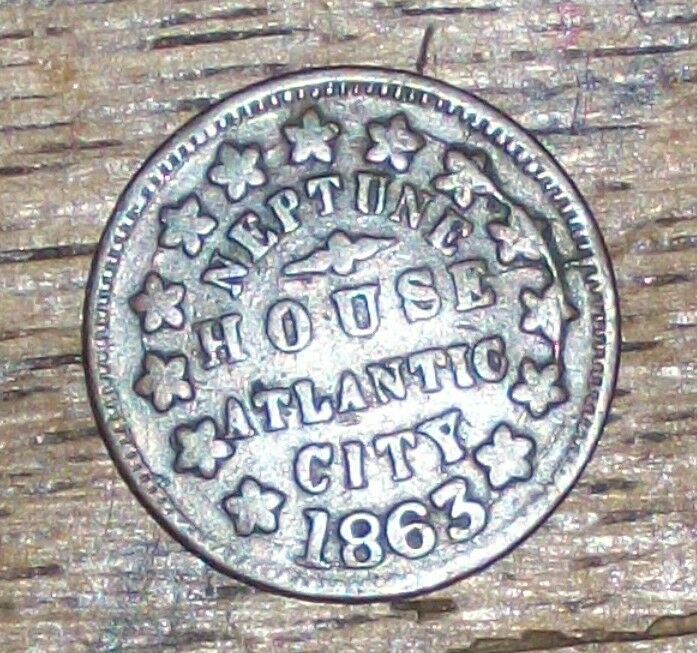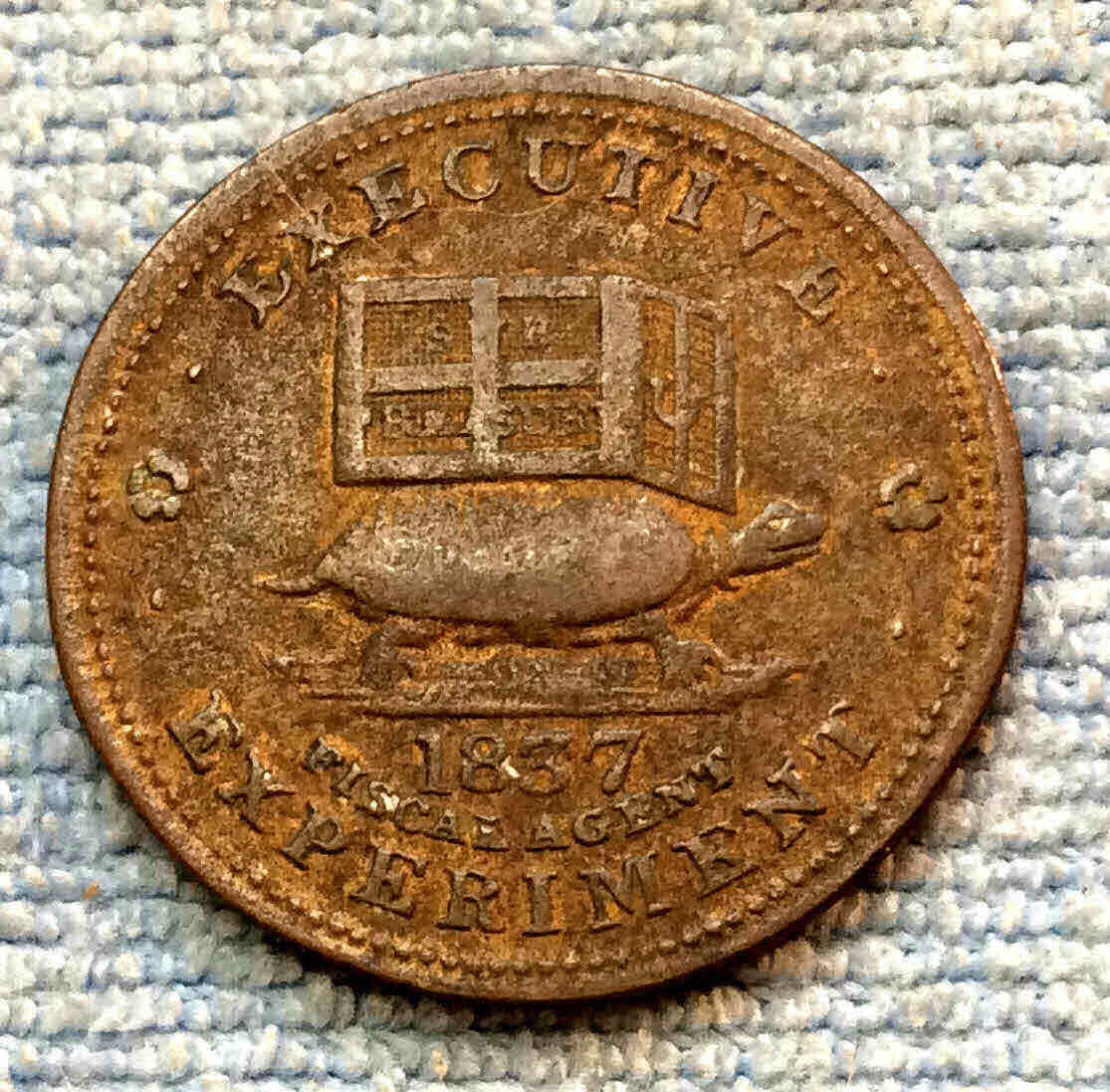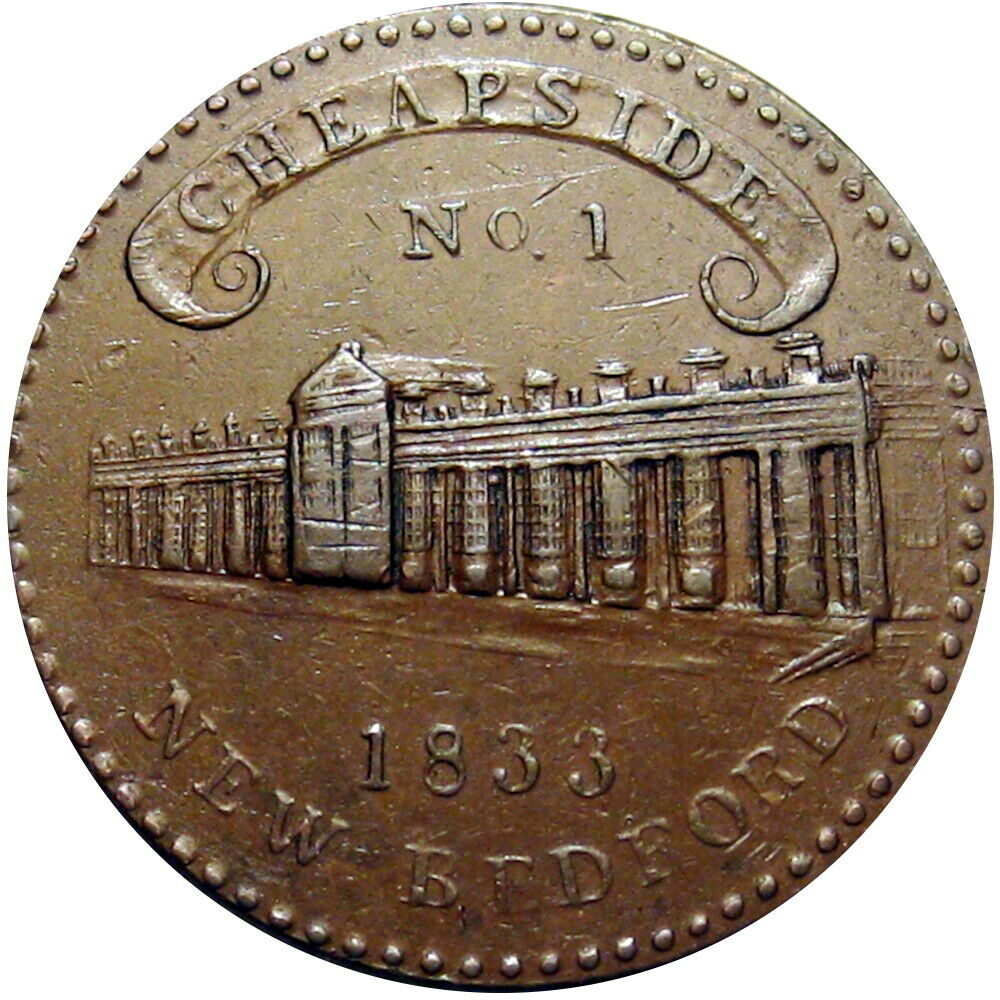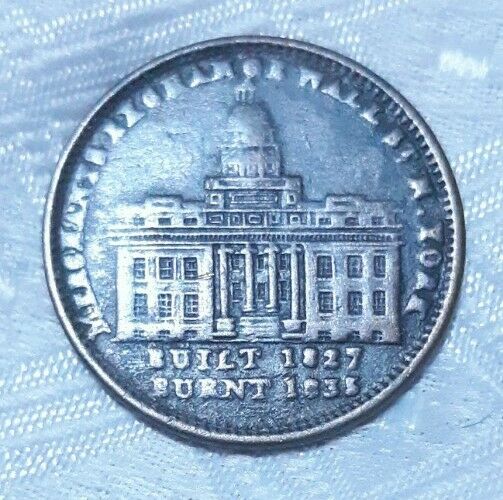-40%
1863 SMICK'S NEPTUNE HOUSE ATLANTIC CITY NEW JERSEY BOARDWALK HOTEL COIN TOKEN
$ 73.92
- Description
- Size Guide
Description
1863 SMICK'S NEPTUNE HOUSE ATLANTIC CITY NEW JERSEY BOARDWALK HOTEL COIN TOKENGREETINGS, FEEL FREE
TO
"SHOP NAKED."
©
We deal in items we believe others will enjoy and want to purchase.
We are not experts.
We welcome any comments, questions, or concerns.
WE ARE TARGETING A GLOBAL MARKET PLACE.
Thanks in advance for your patronage.
Please Be sure to add WDG to your
favorites list
!
NOW FOR YOUR VIEWING PLEASURE…
VINTAGE / ANTIQUE (?)
HARD TIMES TOKEN
FROM
"SMICK'S"
"NEPTUNE HOUSE"
CIRCA 1863
HOTEL / RESORT
ON THE BOARDWALK IN
ATLANTIC CITY, NEW JERSEY (NJ)
BRONZE / COPPER COIN
RARE!!
(IMAGE OF HOTEL AND WRITE UP ARE FOR DISPLAY ONLY)
----------------------------------------------
FYI
Atlantic City is a city located in Atlantic County, New Jersey, USA. As of the United States 2000 Census, the city had a total population of 40,517. It is a resort community located on Absecon Island, off the Atlantic Ocean coast of New Jersey. Other municipalities on the island are Ventnor City, Margate City, and Longport.
History
Atlantic City has always been primarily a resort town. Its location in South Jersey, hugging the Atlantic Ocean between marshlands and islands, presented itself as prime real estate for developers. The city was incorporated in 1854, the same year in which train service began, linking this remote parcel of land with the more populated, urban centers of New York City and Philadelphia, Pennsylvania. Atlantic City became a popular beach destination because of its proximity to Philadelphia.
In 1870 the first boardwalk was built along a portion of the beach to help hotel owners keep sand out of their lobbies. The idea caught on, and the boardwalk was expanded and modified several times in the following years. Today, it is several miles long and sixty feet wide, reinforced with steel and concrete.
The city hosted the 1964 Democratic National Convention which nominated Lyndon Johnson for President and Hubert Humphrey as Vice President. The ticket won in a landslide that November. The convention and the press coverage it generated, however, cast a harsh light on Atlantic City, which by then was in the midst of a long period of economic decline.
Although a small city, it had been plagued with many large city problems, especially poverty and crime. The neighborhood known as the "inlet" was particularly impoverished. In an effort at revitalizing the city, New Jersey voters in 1976 approved casino gambling for the city of Atlantic City. Resorts International became the first legal casino in the eastern United States when it opened on May 26, 1978. Other casinos were soon added along the boardwalk and later in the marina district for a total of twelve today. The introduction of gambling did not, however, quickly eliminate many of the urban problems that plagued Atlantic City. Many have argued that it only served to magnify those problems, as evidenced in the stark contrast between tourism-intensive areas and the adjacent impoverished working-class neighborhoods. In addition, Atlantic City has played second-fiddle to Las Vegas, Nevada as a gambling mecca in the United States. On July 3, 2003, Atlantic City's newest casino, The Borgata, opened with much success.
Atlantic City is home to New Jersey's first wind farm, consisting of five turbine towers approximately 300 feet high each.
North Shore
The Long Branch and Sea-Shore Railroad began building down the coast in 1863, reaching Long Branch two years later on tracks "so close to the ocean beach in some places that the surf blends with the rattle of the cars and the shriek of the locomotive whistle; and at times in high tides, the waves have washed over the track." A little over a decade later, trains were running from Long Branch to Sea Girt and Manasquan in Monmouth County. Meanwhile, the New Jersey and Long Branch Railroad worked its way southward. In 1882, tracks ran from Sandy Hook to Bay Head, where connections were made with the Philadelphia and Camden line of the Pennsylvania Railroad. Traffic along the rails was intense because the New Jersey Southern and Pennsylvania ran on Long Branch and New York tracks. Comparing transportation by mail stage ten years earlier to modern rail travel, an Asbury Park journalist reported that "today fifty-five trains arrive at our station in each twenty-four hours, and all are well loaded." By 1896, reporters announced that "one day last week 776 coaches were used on the New York and Long Branch railroad in transporting people to the seashore. It took twenty-one cars just to carry the baggage away."
During the 1870s-80s, the arrival of the railroad opened southern Monmouth County to more extensive resort growth. Spring Lake represents the type of land speculation that preceded the railroad. Spring Lake was originally four distinct shore communities: Brighton and North Brighton, Villa Park, Spring Lake Beach (named for the fresh-water pond its streets enclosed), and Como, at the north end of the tract. Each settlement grew from one or two large farms into a village centered around a hotel and a railroad station. Undeveloped under a string of owners from the 1760s, the land was subdivided, sold off, and built up during a relatively short time in the last quarter of the nineteenth century. The farmland, dunes, and forests adjacent to the Atlantic Ocean between Lake Como on the north, and Wreck Pond to the south, became an urban grid pattern of streets. In 1872, William Reid and John Rodgers, owners of a prominent stagecoach business, foresaw that their enterprise would be rendered obsolete by the coming railroad and converted their farm near Wreck Pond into Rodger's Villa Park and Reid's Villa Park, which were later combined into a single Villa Park.
In 1873 Joseph Tuttle and William Reid subdivided the Walling Farm and established building lots for the future resort of Brighton. The development of the adjacent Spring Lake Beach area in 1874 followed the founding of the "Villa Parks" and Brighton. Philadelphia fisherman and clergyman Dr. Alfonso A. Willits found the area particularly to his liking and decided to purchase the farmland, developing it into a resort property for wealthy Philadelphians. With the backing of the railroad and members of the Sea Girt Land Association, Willits formed the Spring Lake Beach Improvement Company. Philadelphia engineer Frederick Anspach designed a town plan around the Monmouth House Hotel. The elegant building was "233' long, four stories high, with 270 bedrooms, a dining room seating 1,000 guests, and two large parlors overlooking the ocean." It offered modern amenities such as steam-powered elevators and "electric calls" in every room. Guests visiting the hotel when it opened in 1876 were equipped with boats for restful cruises on the lake and shuttled to and from the railroad station in horse-drawn omnibuses.
Publications, such as Camden's New Jersey Coast Pilot, "a journal devoted to the development and advancement of the interests of the coast region of the state," were a forum for promotion by the "land associations" or development companies. Spring Lake entrepreneurs financed the construction of houses to manage as vacation properties. W.C. Hamilton built the five Victorian cottages pictured in Woolman and Rose's Atlas on romantic tree-filled sites. They mirrored the taste of the times, if not the sandy reality of the beachfront.
By the 1880s, the railroad entrepreneurs reached Barnegat Peninsula, building railways running much of its length, and linking it to the mainland at Point Pleasant to the north and from Seaside Park via trestle eastward to Coates Point at the mouth of Toms River. Anticipating the construction of Central Railroad tracks across the river, businessmen built the Ocean House along the single road to Point Pleasant Beach. The future city's strategic railroad location at the junction of the major New York and Philadelphia lines made it the ideal location for resort development. Speculators began eyeing the area as early as the 1850s, with at least one unsuccessful attempt to subdivide the undeveloped beach lands into one-acre lots. By 1866, the Oceanfront Land Company bought a bankrupt farm along the Manasquan River. John Arnold, a local sea captain, developed another tract of land named "Arnold City" in three hundred lots measuring 50' x 100'; he included the Atlantic View Cemetery for "the benefit" of his buyers. Three years before the railroad arrived in 1881, Trenton investors organized the Point Pleasant Land Company, planned Point Pleasant City and built the Resort House Hotel. The company laid out streets "in a grid-like Philadelphia plan for easy sales," with lots on both sides of the railroad tracks, reaching all the way to the Atlantic Ocean. By 1890, Edwin Salter could report that "eighteen or twenty years ago Point Pleasant was an unimproved, undeveloped tract. [It] is now seen in fine cottages, schools, churches, stores, hotels and boardinghouses standing on well laid-out streets and avenues, where formerly rabbits and reptiles were want to burrow." An estimated 4,000 to 5,000 summer visitors entertained themselves with promenades along the boardwalk and across an iron bridge "lighted with electricity." Point Pleasant's range of accommodations, from hotel rooms at the Resort House to summer cottages for rent each season, rapidly made it one of the most popular summer resorts on the Jersey coast for New Yorkers and Philadelphians. The trolley line between Point Pleasant and Bay Head was completed in 1894, an early sign that the two communities would merge into a continuous settlement.
Captain Arnold illustrated his faith in the railroad by founding the village of Mantoloking. Bay Head, just south of the point, also became an attractive resort possibility during the 1880s. Though the Central Railroad hesitated to push forward, possibly because of the problems its New York and Long Branch line suffered along the narrow Sea Bright Peninsula, it was encouraged to proceed by the establishment of a Pennsylvania Railroad line. In 1880, a group of visionary Philadelphians convinced of the resort's financial potential, supported the railroad company's line from Pemberton to the shore. [49] Roads were built, with bridges to the mainland, and in the twentieth century, new hamlets filled every inch of land among the towns and even crept out onto Barnegat Bay islands that barely rise above the water line. In the process of this rapid development, much of the natural landscape that initially inspired settlement has disappeared.
Bay Head, at the head of Barnegat Bay, was founded by a triumvirate of Princeton bankers. "The big three rode into town on a summer day in 1877," finding dunes, tall grasses, a pond, the bay, bushes, meadows, marshes, and "the smell of the sea." Edward Howe, William Harris, and David Mount apparently saw opportunity, too, for they bought 45 acres from Capt. Elijah Chadwick and founded the Bay Head Land Company in 1879. The Bellevue Hotel, the first of five big hotels, accommodated visitors by 1881, when the New York and Long Branch Railroad was extended to Bay Head from Manasquan on the north. The Pennsylvania also opened its line from Seaside Park, which connected via trestle to the mainland. Before the new bridge, all supplies had arrived by boat. Almost immediately after the crossing was completed, wood-shingled summer homes were erected along the beach and private estates appeared on the shore of Barnegat Bay.
Bay Head managed to attract the genteel clientele desired (Princeton University faculty and founding bankers) with lots sold under deeds prohibiting everything from beer to slaughterhouses. Evidence of this exclusivity is still visible today, both in street names remembering Princeton professors and rows of well-preserved houses. "Houses at Deal and Elberon or Margate may be bigger and brighter and more costly," says one Jersey Shore chronicler, "but the Bay Head-Mantoloking homes, set comfortably in reasonably well-preserved dunes, are like the etchings of seaside 'cottages' in Harper's Magazine. There is unshowey evidence of wealth, of conservativism—the expensive 'natural' look, the 'Ivy League' look, so to speak."
A contrasting but perhaps fictitious side of Bay Head was recorded in the novel 1919, part of John Dos Passos' trilogy USA. Richard Ellsworth Savage, one of the book's multitude of shallow characters, comes of age working in a local hotel. Savage discovers Christianity at St. Mary-by-the-Sea Church, meanwhile getting involved with the church minister's wife, whom he sees every Sunday night when the minister goes off to preach in Elberon. Dos Passos himself, who apparently visited in 1918, recorded a sunnier outlook in his diary: "Could anything be stranger than the contrast between Bay Head—the little square houses in rows, the drugstores, the boardwalks, the gawky angular smiling existence of an American summer resort—and my life for the last year. Hurrah for contrast." In Bay Head several stores and an Applegate's Garage opened to serve the locals, but no substantial business district developed, and residents were forced to bring staples from Point Pleasant. The city was connected to Bay Head by a streetcar that ran in the summer between 1903 and 1919.
Elmer Cottage
Mantoloking, adjoining Bay Head to the south, is the name of uncertain Indian origin given to a ritzy seaside summer cottage community planned by New York real estate promoters. Frederick W. Downer began assembling land in 1875, for what was to become a resort based, not on lodging, but ownership. John Arnold organized the Sea-Shore Land and Improvement Company in 1878 and began selling lots for the future city. To attract wealthy buyers, he imported topsoil and offered, on this parched, windswept sliver of land, the possibility of luxurious lawns. Rather than locate a public boardwalk or a street directly at the ocean, as in more populist beach communities like Ocean Grove, the choicest lots were fronted to give privileged buyers the beach and view all to themselves. The large number of shingled mansions still standing, such as 1237 Ocean Avenue, perhaps testify to the success of this formula; some people built cottages complete with carriagehouses, as at 1233 Bay Avenue.
The history of Lavallette parallels that of Mantoloking and Bay Head farther north, having been opened by a land "improvement" company in the 1880s and prospering with the coming of the railroad. It also benefitted from a growth of leisure time in America among the classes to whom it catered—doctors, lawyers, and successful businessmen who, by the 1880s, could afford to buy or build summer homes and take time off from work to spend at them. One local builder was Capt. McCormick. Peter Bloom advertised himself as "pioneer carpenter and builder" in 1937. Fire and demolition have destroyed many early buildings, and the automobile has brought a blighted, worn appearance to the city's main street, Grand Central Avenue. "There is little if any discernible concern for preservation in the town," according to the report on Lavallette in the historic sites study of Ocean County. Despite this laissez-faire attitude toward history, much of old Lavallette remains; of particular interest are the Lavallette Hotel on Grand Central Avenue and the Lavallette Theater to the south, whose stucco alterations suggest an effort to streamline and modernize.
Between 1875 and 1880, the railroad began bringing visitors to the shore communities south of Ocean Grove and Bradley Beach. Speculators anticipating opportunities for land development "followed the tracks" down the shore to Ocean Beach, now known as Belmar. The founders, originally from Ocean Grove, predicted that people would want to move up to larger, more luxurious homes on the Jersey Shore. For 0,172.50 they bought what amounted to a 372-acre peninsula of land bounded by a mile of Atlantic Ocean on the east, and a mile-and-a-half of the lake and inlet formed by the Shark River on the north and west. Operating first as the Pleasant Beach Association and later as the Ocean Beach Association, the founders employed the typical superlatives to entice prospective buyers. "This tract is considered the finest location on the Atlantic Coast, for a summer resort one of the most beautiful landscapes imaginable." In 1875, the 2-year-old Ocean Beach Association advertised half-price lots for hotel builders. The following year, a stage line was established between Ocean Grove and Ocean Beach and a promotional auction was held during one of Ocean Grove's camp meetings to sell lots in the new community. Potential investors traveled on excursion tickets from cities along the Pennsylvania line, which added extra cars for travel to the auction from Philadelphia. The successful scheme resulted in the sale of 135 lots and a record number of passengers aboard the Pennsylvania Railroad. By 1878, Ocean Beach entertained the patrons of five hotels:
Riverview House, Colorado House,
Neptune House
, Fifth Avenue House, and Columbia House. Twelve 80'-wide avenues were laid out perpendicular to the shore, each block being divided into 50' x 150' lots. Depending on location, these were sold for 0 to ,500 with deeds requiring buyers to build cottages.
(THIS PICTURE FOR DISPLAY ONLY
)
---------------------------
Thanks for choosing our store. You may email for alternate payment arrangements. We combine shipping. Please pay promptly after the auction. The item will be shipped upon receipt of funds. WE ARE GOING GREEN, SO WE DO SOMETIMES USE CLEAN RECYCLED MATERIALS TO SHIP.
Please leave feedback when you have received the item and are satisfied. Please respond when you have received the item * If you were pleased with this transaction, please respond with all 5 stars! If you are not pleased, let us know via e-mail. Our goal is for 5-star service. We want you to be a satisfied, return customer.
Please express any concerns or questions. More pictures are available upon request. The winning bid will incur the cost of S/H INSURED FEDEX OR USPS. See rate calculator or email FOR ESTIMATE. International Bidders are Welcome but be mindful if your country is excluded from safe shipping.
Thanks for perusing
THIS
and
ALL
our auctions.
Please Check out our
other items
!
WE like the curious and odd.
BUY, BYE!!
Get Images that
Make Supersized Seem Small.
Get Auctiva's Listing Templates
on your items with a few clicks.
Attention Sellers - Get Templates
Image Hosting, Scheduling at Auctiva.com.
Track Page Views With
Auctiva's FREE Counter














